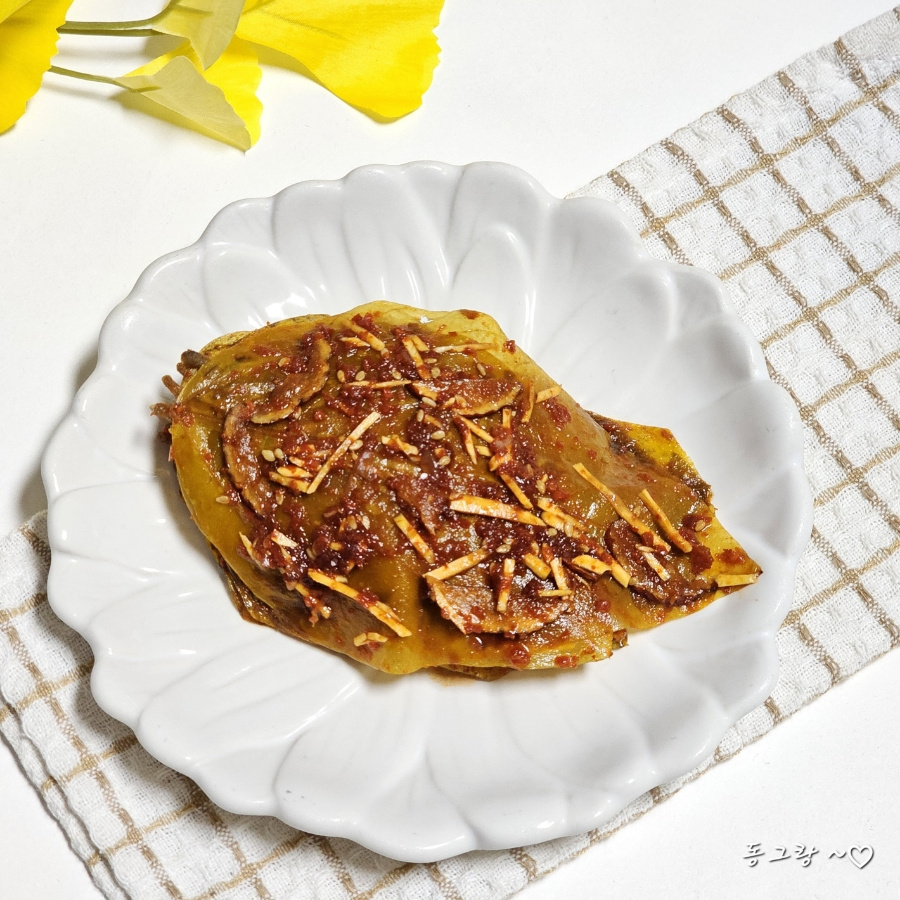Savory and Sweet Maple Bean Leaf Jangajji (Kimchi)
A Spring Delicacy: Delicious Jangajji and Fermented Bean Leaf Kimchi Made with Maple Bean Leaves

Introducing a recipe for Maple Bean Leaf Jangajji (Kimchi) – a flavorful side dish made by seasoning chewy and aromatic fermented maple bean leaves with a savory and sweet sauce. Chestnuts and dates are added to enhance the flavor.
Main Ingredients- Maple bean leaves (fermented in brine) – 3 bundles
- Chestnuts – 5 pcs
- Dried dates – 5 pcs
- Kelp-infused water – 5 Tbsp (Infuse 1 piece of kelp in 1 cup of water for 5 minutes)
Seasoning Ingredients- Minced garlic – 2 Tbsp
- Ginger paste (or minced ginger) – 1 tsp
- Red pepper flakes – 7 Tbsp
- Sugar – 2 Tbsp
- Fish sauce – 5 Tbsp
- Soy sauce – 5 Tbsp
- Oligosaccharide – 5 Tbsp
- Plum extract – 2 Tbsp
- Toasted sesame seeds – 2 Tbsp
- Minced garlic – 2 Tbsp
- Ginger paste (or minced ginger) – 1 tsp
- Red pepper flakes – 7 Tbsp
- Sugar – 2 Tbsp
- Fish sauce – 5 Tbsp
- Soy sauce – 5 Tbsp
- Oligosaccharide – 5 Tbsp
- Plum extract – 2 Tbsp
- Toasted sesame seeds – 2 Tbsp
Cooking Instructions
Step 1
These are fermented maple bean leaves purchased from a traditional market. Although they may seem like a small amount, they become quite generous once prepared. These bean leaves are fermented in brine for over two weeks, giving them a distinct, deep flavor with a slight tang. They might have a faint pungent aroma, which we’ll eliminate during the cooking process.

Step 2
First, soak the fermented bean leaves in cold water to remove bitterness and any pungent smell. Initially, the water will turn a deep brown, but change the water multiple times until it becomes clear. I started this process in the evening, changing the water every hour and leaving them to soak until the next morning. This step significantly reduces the characteristic smell of the bean leaves.

Step 3
After soaking, place the bean leaves in a pot and boil them for about 20-30 minutes until they become tender. Softened bean leaves will absorb the seasoning better and be more pleasant to eat.

Step 4
Bean leaves tend to float on water, so it’s important to press them down while boiling to ensure even cooking. Place the bean leaves in a wok (or a large pot), and use a lid or a heavy object to keep them submerged in the water. Boiling them while covered and pressed down will allow them to cook evenly.

Step 5
During boiling, check the tough vein of the bean leaves. They are ready when the veins become soft and bend easily.

Step 6
After boiling, soak the bean leaves again in fresh cold water for an additional 1-2 hours. This crucial step removes any remaining pungent odor, ensuring the bean leaves are clean-tasting.

Step 7
Once thoroughly rinsed, take the bean leaves and squeeze out as much water as possible using both hands. Properly squeezing out the water prevents the seasoning from becoming watery and ensures a well-seasoned dish.

Step 8
Now, let’s make the kelp-infused water. Pour 1 cup of water into a cup, add a piece of kelp about the size of your palm, and let it steep for about 5 minutes to extract its umami flavor. This water will add depth to the seasoning.

Step 9
Peel the chestnuts and thinly julienne them. The sweetness of the chestnuts will enrich the flavor of the bean leaf jangajji.

Step 10
Rinse the 5 dried dates thoroughly to remove any dust. Pat them dry, remove the pits, and julienne them finely. The subtle sweetness and aroma of the dates complement the bean leaves wonderfully.

Step 11
It’s time to make the delicious seasoning! In a bowl, combine 2 Tbsp minced garlic, 1 tsp ginger paste (or minced ginger), 7 Tbsp red pepper flakes, 2 Tbsp sugar, 5 Tbsp fish sauce, 5 Tbsp soy sauce, 5 Tbsp oligosaccharide, 2 Tbsp plum extract, and finally, 2 Tbsp toasted sesame seeds. (Note: You can substitute soy sauce for fish sauce, but fish sauce will provide a richer umami flavor.)

Step 12
Add the julienned chestnuts and dates to the prepared seasoning mixture. Mix everything thoroughly with a spoon until well combined, allowing the flavors to meld.

Step 13
In a large bowl, place the seasoned chestnuts and dates, then add the squeezed bean leaves. It’s now time to coat the bean leaves with the seasoning.

Step 14
Instead of seasoning each bean leaf individually, it’s tastier to stack them in layers of 2-3 or 3-4 leaves and apply the seasoning to the stacks. When layered like this, the seasoning seeps in between the leaves, allowing the flavors to naturally penetrate and deepen over time. (Pro Tip: Avoid using too much seasoning, as it can make the dish taste greasy; adjust the amount according to the quantity of bean leaves.)

Step 15
This finished Maple Bean Leaf Jangajji has a wonderfully chewy texture and is a fantastic side dish that will make you want to eat bowl after bowl of rice. The flavor deepens over time, so it tastes even better after a few days!




